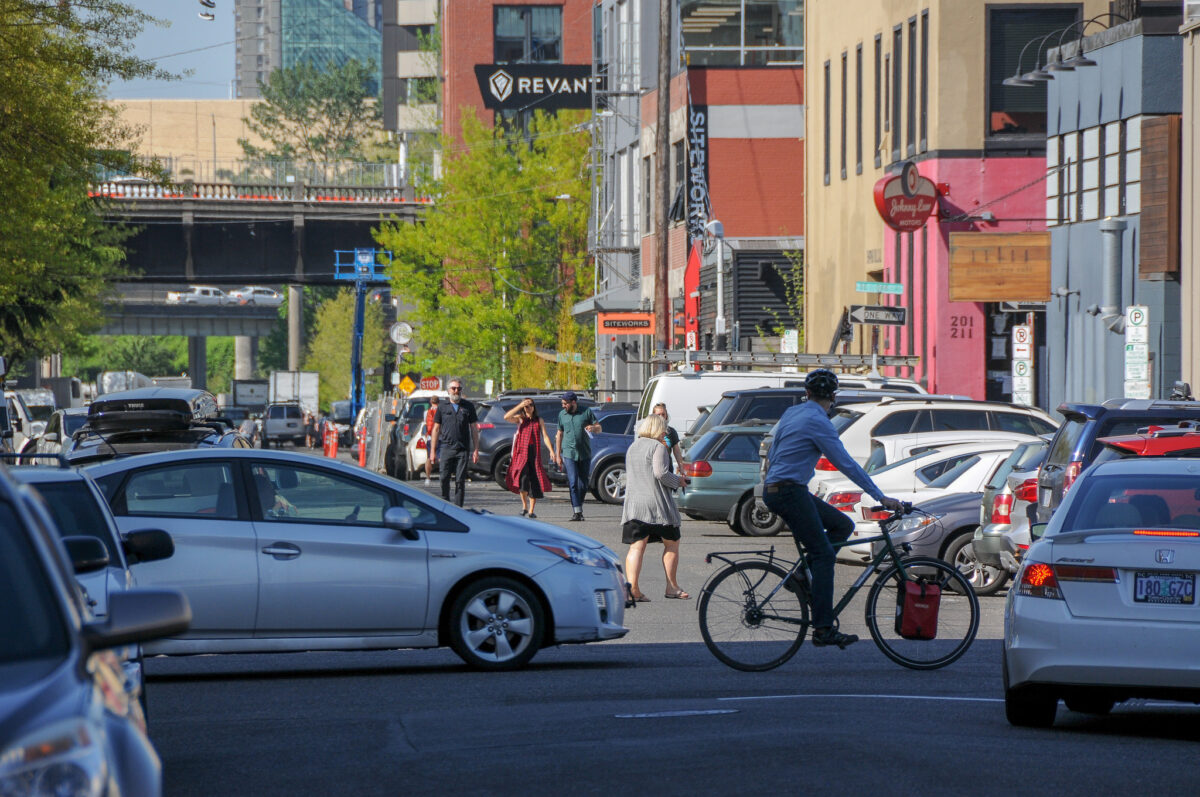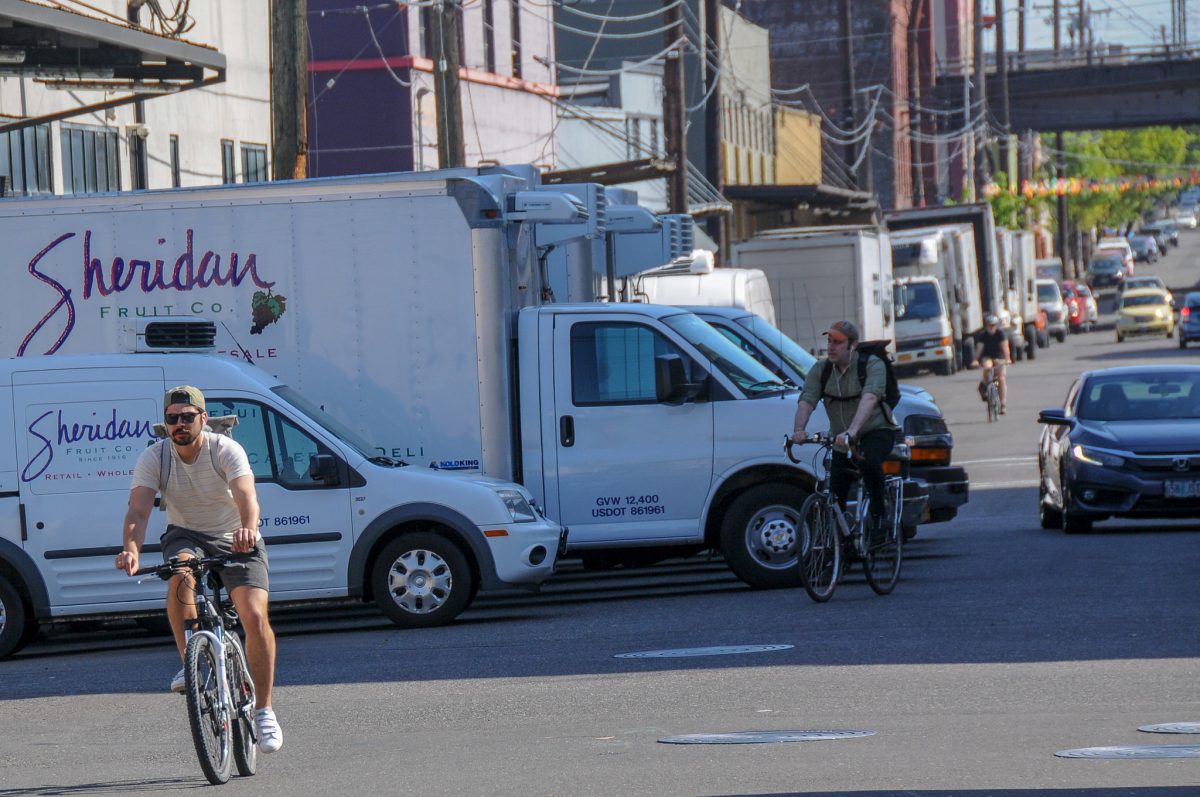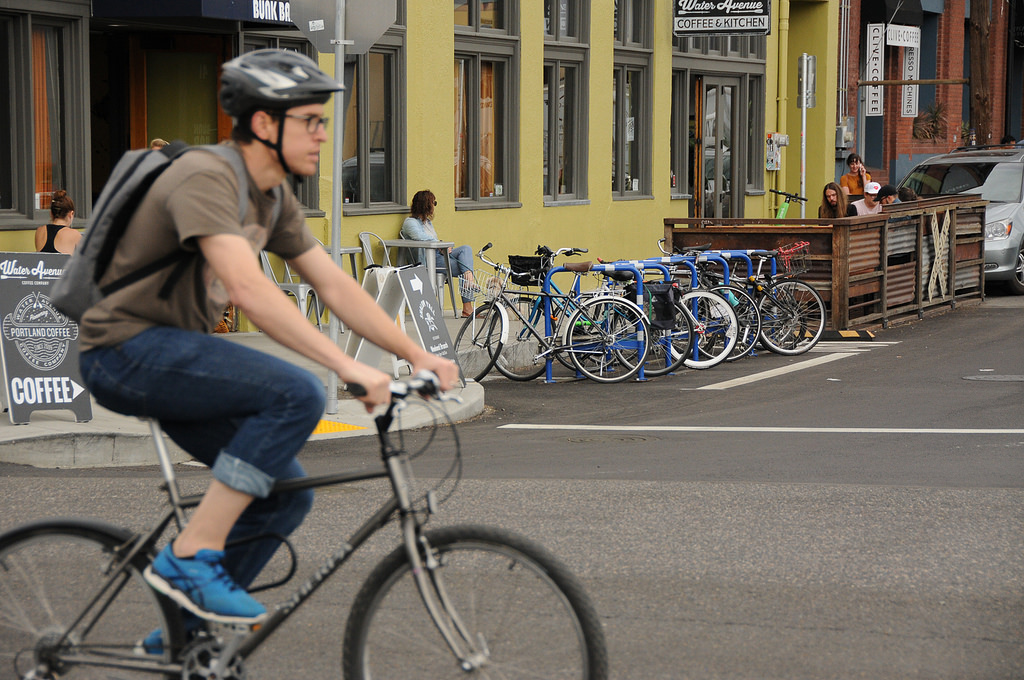
(Photos: Jonathan Maus/BikePortland)
The Central Eastside Industrial Council (CEIC) says the city’s plan to update streets in the central city is moving too fast. The nonprofit is also urging its members to voice concerns over the potential loss of 250 auto parking spaces and fewer lanes for driving.
“We can’t handle the loss of 250 parking spaces. We would like to work with the City and the bike community to find a more measured and balanced plan.”
— Kate Merrill, Central Eastside Industrial Council executive director
As we reported last week, Portland’s transportation bureau is polishing up its list of projects that will get built starting next year through the Central City in Motion plan. With a $9 million budget (and $30 million forecasted), PBOT wants to make significant changes to streets in order to provide more space for cycling, walking, and transit vehicles. Once completed, PBOT says the redesigned streets will be able move more people, more safely.
The central eastside — a rapidly-changing industrial zone along the Willamette River between the Lloyd District and OMSI — is a key part of the transportation network that must adapt to current and expected growth for Portland to reach greenhouse gas emission reduction and mode split (the percentage of trips made by transit, feet, bike, car, and so on) goals.
But while PBOT says the projects are needed to handle growth, the CEIC says a sudden loss of auto parking and space for driving would hinder it.
On September 7th, the CEIC sent a call-to-action email to its members with a warning in the subject line: “We could lose 250 parking spaces in the Central Eastside.”
Here’s more from the email:
“In a growing district with no public off-street parking, that’s a lot!… this ambitious plan is called Central City in Motion. It aims to, ‘invest and upgrade the existing roads, sidewalks, bike lanes and crossings to make the transportation system work better for everyone.’ However, many of the projects call for the loss of lanes or the loss of parking. If all projects are approved by City Council in October we could lose over 250 parking spaces.”
The email specifically calls out PBOT’s proposal for 6th/7th (project #3) and 11th/12th (project #4).
In order to build protected lanes for cycling on 7th, PBOT would re-allocate space currently used for parking cars on one side of the street between NE Sandy and SE Division. Depending on the final design, that move would result in the loss of 112 or 100 auto parking spaces. On 12th, PBOT is proposing to change the configuration of the street from two lanes where drivers are allowed, to one. It would be replaced with a lane for cycling and other light mobility vehicles that’s protected from car and truck drivers. That design would lead to parking losses on one side of NE 12th between Burnside and Irving. Other areas in the central eastside where parking would no longer be allowed include: SE Clay Street from SE Water Avenue to SE Grand Avenue; along the west side of SE Water Avenue; small sections along SE Clay Street between SE Grand and Ladd, and at intersections of SE Hawthorne at 7th and SE 12th Avenue to allow for bus queue jump lanes.
That’s too much, too soon for the CEIC.


Advertisement

“Public transit and biking aren’t realistic alternatives for everyone at the current time.”
— Rina Jimmerson, CEIC Transportation Policy Advisory Committee Chair
Reached for comment about the email, the CEIC’s Transportation Policy Advisory Committee Program Manager Rina Jimmerson (a position and program wholly funded by PBOT parking meter revenue, more on that below) said she’s worried that a lack of auto parking could slow the area’s growth. Jimmerson said our current transit system “doesn’t suit the needs” of 7,000 central eastside employees who work in the manufacturing and distribution sector. “Many can’t afford to live in the urban core and live in areas poorly served by public transit, need their cars/trucks for hauling goods, and/or have swing shifts that start too early for TriMet hours,” she said. A lack nearby daycare options also forces people to drive, she added.
According to Jimmerson, parking has become “very problematic” for the district in recent years. “We strive to encourage less single occupancy vehicle trips… However, we recognize that public transit and biking aren’t realistic alternatives for everyone at the current time.”
“We recognize that transit, walking and biking won’t serve every trip, but we also know that when we give people options, they take them.”
— John Brady, PBOT
A central eastside commuting survey promoted by the CEIC this past spring found that 18% of the 463 respondents bike, walk, or take transit. 63% said they drive alone, but when asked what other modes they’re interested in, 39% said they’d like to take transit and 17% said they want to give Biketown a try.
CEIC Executive Director Kate Merrill told us her main concern is that PBOT’s outreach has been inadequate. “The process has been problematic,” she emailed to us yesterday. “Our constituents feel that this process hasn’t been done in a deliberate way with the proper outreach or research.” Merrill wants the process to slow down. She’s also concerned about parking. “We can’t handle the loss of 250 parking spaces,” she wrote. “We would like to work with the City and the bike community to find a more measured and balanced plan moving forward that responds to our district’s immediate, mid and long term needs.”
According to my notes, it appears PBOT has bent over backwards to keep the CEIC informed.

There was the meeting I attended in March, the CEIC transportation open house in April (that featured PBOT staff being grilled by local business owners about Central City in Motion projects), a workshop on July 26th, and a presentation to the CEIC Freight Advisory Committee on September 6th. That meeting included a presentation of the 22-page Central Eastside Industrial District Freight Impact Study that PBOT completed at the CEIC’s behest. PBOT staff also attended several CEIC transportation committee meetings to provide updates on the project and held individual, one-on-one meetings with freight company representatives in the district.
Despite this, Merrill maintains that, “Many businesses feel that they haven’t been adequately informed.”
PBOT Communications Director John Brady disagrees. He told us via email that their outreach has been, “deliberate and inclusive.”
Keep in mind that PBOT and the CEIC are close partners. At least on paper. In April 2013, as part of a deal to bring metered parking to the area, City Council approved an ordinance to use a portion of meter revenue to create the Transportation Policy Advisory Committee (which Jimmerson leads) within the CEIC in order to, “leverage the transportation and parking systems to assist, foster, and expand employment and business growth” and to, “Decrease SOV demand on the regional transportation system by facilitating non-drive-alone transportation options.” The TPAC’s 2017/2018 budget was $1.47 million.
As for parking spaces and the future of driving, Brady acknowledges the hard decisions required to change the status quo, but said PBOT is committed to their adopted goals. “PBOT wants to give new commuters and residents in our Central City real choices for how they get around, whether they want to walk, take transit, bike or work from home,” he shared in an email yesterday. “The project underscores the hard choices we face at PBOT – in some cases a new bus lane or bikeway is proposed where there is currently on-street parking – but we’ve been transparent about that from the beginning.”
“We recognize that transit, walking and biking won’t serve every trip,” Brady added, “but we also know that when we give people options, they take them.”
— Jonathan Maus: (503) 706-8804, @jonathan_maus on Twitter and jonathan@bikeportland.org
Never miss a story. Sign-up for the daily BP Headlines email.
BikePortland needs your support.

